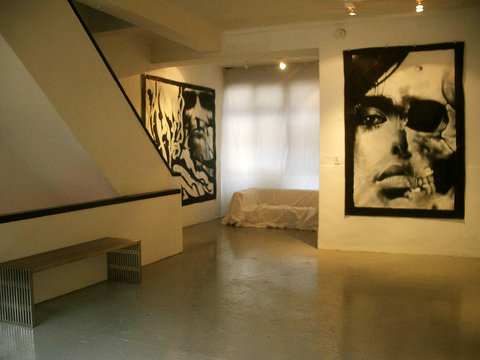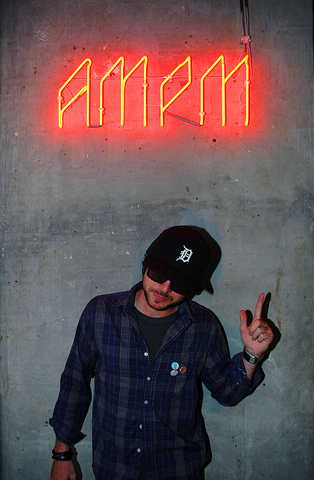BAPE, Proton, K-Swiss and Motorola are companies that manufacture completely different products — clothes, TVs, shoes and mobile phones — but all have worked with street artists to promote their wares.
In a world obsessed with cool and the next big thing, forward-thinking companies are desperate to impress trend-setting buyers. One of the easiest, and most successful, ways to do that is to associate their products with high-profile artists, and the cooler the better.
In Taipei, local street artists Reach and Ano tagged Proton TVs. UK legend She1 did a live painting for Royal Elastics in May. And K-Swiss flew out Fremantle and Grand High from France and the US respectively for K Spray 2 in April. Breaking away from this commercial trend, AMPM Gallery is taking back the street by hanging graffiti on its walls.

PHOTO COURTESY OF DBSK1
The appropriation of street art by company marketing machines sits awkwardly with an art form that is viewed as vandalism by authorities and the practitioners of which often break the law.
Despite its proliferation on the Internet, and use in slick PR campaigns, graffiti and stenciling retain a rebellious streak. Sharing that belief in rebelliousness, even if sometimes misplaced, like-minded artists have created grassroots communities.
DBSK1, a foreign graffiti artist living in Taipei, opened AMPM Gallery in March last year as a venue to showcase street art, free from the glare of authorities.

PHOTO COURTESY OF SARAH MCMASTER
DBSK1 and his old crew, Asia Nites, were frustrated with the availability and quality of places to display street art. They aimed to display less commercial forms of street art than big companies were using to market their products. "I'm not against [these corporate shows]," said DBSK1. "An artist, to a certain extent, has to support themselves and I understand doing crossover stuff. But it makes the scene more commercialized," and thus, "softer." What's lost, then, is the street edge or style. Through exhibiting work by local and foreign artists, AMPM aims to reconnect street art to unconformity, even if it is displayed in a gallery.
All of AMPM’s four shows so far have featured local talent. Love Hotel, the gallery’s first show, exhibited the work of 22 artists. The second, featured Beans & Bueller's twisted, yet cute, puppets roaming a post-apocalyptic city. AMPM’s last show displayed photography by Kent Dylan and finished yesterday.
So far, the shows have attracted a peculiar mix of foreigner party people, local graffiti kids, hipsters, and middle-aged spectators. "It's really cool; I really like [the mix we've got]," says DBSK1. "But it's not consistent. We want to hype" the venue and take it to the next level, to educate the general public about the art that's happening in their city.
AMPM’s Notebook exhibition starts Saturday and examines the artistic process. Over 20 artists' notebooks will be posted throughout the gallery, allowing viewers a rare glimpse into each individual's personal world and their creative process. Attendees are encouraged to take along their own sketches. The show of rough drafts, sketches, and random, spontaneous work provides a unique insight into members of Taipei’s art scene.

We lay transfixed under our blankets as the silhouettes of manta rays temporarily eclipsed the moon above us, and flickers of shadow at our feet revealed smaller fish darting in and out of the shelter of the sunken ship. Unwilling to close our eyes against this magnificent spectacle, we continued to watch, oohing and aahing, until the darkness and the exhaustion of the day’s events finally caught up with us and we fell into a deep slumber. Falling asleep under 1.5 million gallons of seawater in relative comfort was undoubtedly the highlight of the weekend, but the rest of the tour

Youngdoung Tenzin is living history of modern Tibet. The Chinese government on Dec. 22 last year sanctioned him along with 19 other Canadians who were associated with the Canada Tibet Committee and the Uighur Rights Advocacy Project. A former political chair of the Canadian Tibetan Association of Ontario and community outreach manager for the Canada Tibet Committee, he is now a lecturer and researcher in Environmental Chemistry at the University of Toronto. “I was born into a nomadic Tibetan family in Tibet,” he says. “I came to India in 1999, when I was 11. I even met [His Holiness] the 14th the Dalai

Music played in a wedding hall in western Japan as Yurina Noguchi, wearing a white gown and tiara, dabbed away tears, taking in the words of her husband-to-be: an AI-generated persona gazing out from a smartphone screen. “At first, Klaus was just someone to talk with, but we gradually became closer,” said the 32-year-old call center operator, referring to the artificial intelligence persona. “I started to have feelings for Klaus. We started dating and after a while he proposed to me. I accepted, and now we’re a couple.” Many in Japan, the birthplace of anime, have shown extreme devotion to fictional characters and

Following the rollercoaster ride of 2025, next year is already shaping up to be dramatic. The ongoing constitutional crises and the nine-in-one local elections are already dominating the landscape. The constitutional crises are the ones to lose sleep over. Though much business is still being conducted, crucial items such as next year’s budget, civil servant pensions and the proposed eight-year NT$1.25 trillion (approx US$40 billion) special defense budget are still being contested. There are, however, two glimmers of hope. One is that the legally contested move by five of the eight grand justices on the Constitutional Court’s ad hoc move